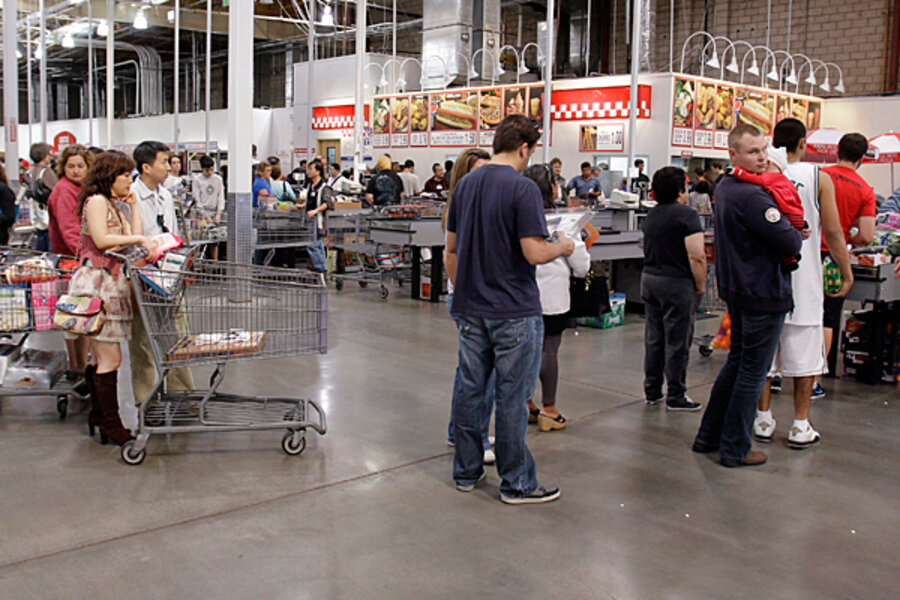Inflation rate headed up? The impact of higher food, energy prices.
Loading...
| New York
The warning flags on the inflation rate are starting to flutter.
Higher food and energy prices helped propel the Producer Price Index (PPI) up by 1.1 percent in December, the Labor Department reported Thursday. This is the biggest monthly change in the past year.
On Friday, when the Consumer Price Index for December comes out, economists will watch to see if the price hikes for manufacturers have been passed through to consumers. Wall Street expects the report will show a rise of 0.4 percent for the month.
But food and energy prices have been higher than anticipated, and that could push the figure up to as much as 0.7 percent, which is an annualized rate of 8.7 percent, predicts economist Joel Naroff of Naroff Economic Advisors in Holland, Pa.
Rising food and energy prices for consumers have larger implications for the economy. Both involve products that most consumers need to buy. Thus, any increase in their prices pulls money out of shoppers’ disposable income.
“The rising food and energy costs tell me the first quarter is going to be uglier in terms of gross domestic product growth,” Mr. Naroff says. “I am already starting to mark down how fast the economy is growing.”
If the Federal Reserve is concerned about inflation, it may start to raise short-term interest rates, which are currently about zero percent. Normally, however, the Fed discounts increases in food and energy prices, because the nation’s central bank can do little to affect them.
One thing that’s been rising is the price of fresh fruit and vegetables. For example, in December, the wholesale price of vegetables rose by 22.8 percent, and fruit was up 15.4 percent.
A big factor in the rise was the early cold snap that hit Florida. There have been big losses in sweet corn, green beans, peppers, cucumbers, and squash, according to Lisa Lochridge, a spokeswoman for the Florida Fruit and Vegetable Association.
“The cold hit right before the crops were harvested,” she says.
The fruit side saw some damage, she says, but it was not “catastrophic.” Nonetheless, on Wednesday, the US Department of Agriculture scaled down its estimate of the size of the citrus crop.
Food-price increases go beyond Florida. The price of beef rose 2.7 percent in December and was 15 percent higher than a year ago, the Department of Labor said in the PPI report. Pork is up 22.3 percent from a year ago, and fish is up almost as much. Turkey is up 18 percent.
Most of those increases have yet to be passed on to consumers, says economist Bill Lapp of Advanced Economic Solutions in Omaha, Neb. But, he warns, “a cost bubble has moved into the system.”
Down the road, these higher costs will be passed along, Mr. Lapp says. “It won’t happen overnight, but eventually, as companies feel more confident, they will pass on those higher costs to the consumer,” he says.
The higher prices won’t be just at the grocery store. As restaurants feel the cost pressures, they, too, will want to raise prices, says Lapp.
By the end of the year, he says, food prices overall will be up by 3.5 percent to 5 percent.
One food-related unknown is the extent of damage to the wheat crop as a result of the flooding in Queensland, Australia. However, as Lapp notes, Queensland produces only 10 percent of Australia’s wheat crop. But the United States also imports lean beef from Australia, and that may be adversely affected by the flooding, he says.
In addition, Queensland exports a large quantity of coking coal, used to make steel. Many of the rail lines used to get the coal to port are now cut off. On Thursday, the Commonwealth Bank of Australia warned that prices could rise.
On the energy front, the price of gasoline rose almost 5 percent just in the month of December. According to AAA, the national driving club, the price of a gallon of gasoline is up to $3.10 a gallon as of Thursday – up 13 cents a gallon from November and up 35 cents a gallon from a year ago.
Still, the inflation outlook is not entirely bleak, says Daniel Meckstroth, chief economist at the Manufacturers Alliance/MAPI in Arlington, Va. Aside from food and energy, most price increases have been modest, he says. In the December PPI numbers, finished goods, without energy and food, rose by 0.2 percent. “Commodities are a relatively small part of manufacturing costs,” he says.
Moreover, he expects manufacturing productivity to grow by at least 3 percent in 2010. “In addition, labor costs have barely risen because of all the unemployment,” he says.
Nevertheless, he anticipates some upward pressure on inflation in 2011. “But I don’t think it will be enough to worry the Federal Reserve Board,” he predicts.
Naroff, however, disagrees. The Fed will start to feel uncomfortable with prices by the end of summer or early fall, he says. That is when the nation’s central bank will start to raise interest rates, he says.





